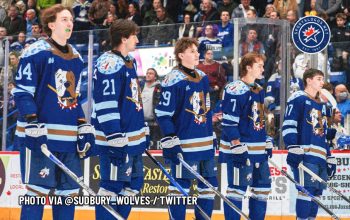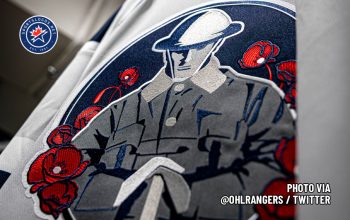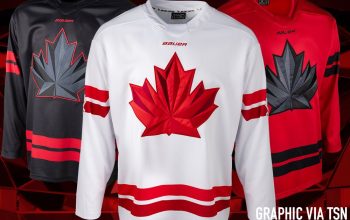Designed by a Philadelphia ad man in the mid-1960s, the Philadelphia Flyers’ primary logo has not been altered in its nearly 50 years of existence. Before the Flyers’ first season in 1967-68, the team adopted a name suggested by an owner’s sister, borrowed colors from a university in Texas, and chose a spelling that dictionaries identify as the second option.
I recently spoke with Hall of Fame hockey writer Jay Greenberg, who covered the Flyers for many years, and who literally wrote the book, called Full Spectrum, on the Flyers’ early years. The way Greenberg tells it, the team name arrived in an “Aha!” moment on the New Jersey Turnpike in 1966.
“The team was named by [team owner Ed] Snider’s sister Phyllis,” Greenberg said. “The original founders of the team were driving home from a show in New York and stopped for a snack on the New Jersey Turnpike, and were kicking around names.”
In his book, Greenberg quotes Phyllis, who was married to Earl Foreman, one of the original investors in the team: “I was thinking of people skating and sliding around the ice, and the ‘Flyers’ just popped into my head. Everybody thought it was great.”
 Officially, the name derived from a name-the-team contest that received 11,000 entries. “They were running a contest to name the team,” Greenberg said, “but the contest, Ed Snider said later, was kind of rigged. They had already decided on Flyers.” (Important note: Name-the-team contests are ALWAYS rigged, so it’s nice to see things were no different back then.)
Officially, the name derived from a name-the-team contest that received 11,000 entries. “They were running a contest to name the team,” Greenberg said, “but the contest, Ed Snider said later, was kind of rigged. They had already decided on Flyers.” (Important note: Name-the-team contests are ALWAYS rigged, so it’s nice to see things were no different back then.)
A nine-year-old boy named Alec Stockard was selected from all the fans who submitted the name Flyers (or Fliers, or Phlyers, or Phliers) to the contest, and he won season tickets and a 21-inch RCA television set. Other team names submitted included, according to Greenberg, the Ice Picks, the Acmes, the Philly Billies, the Green Backs, the Scars and Stripes, the Croaking Crickets, the Liberty Bells, the Quakers, and the Ramblers.
Two of those names represented teams who had previously played in the city. The Quakers played one NHL season in Philadelphia in 1930-31, and the name did not conjure positive memories. “They were still in the record book with having the fewest wins in history,” Greenberg said. “They won four games that year.”
The Ramblers were a minor league team that played from 1935 to 1941. “But the Ramblers had played at the ramshackle Philadelphia Arena in West Philly,” Greenberg said, “and they wanted people to understand that this was a new team and a Major League team.”
Once the name was selected, the team needed to decide on a spelling. The contest winner, Alec Stockard, had spelled the name as it comes first in the dictionary, Fliers. “When I did the book,” Greenberg said, “I asked all the founders of the franchise, did they remember why they went with Y instead of I, and nobody could remember.”
 The logo and original uniforms were designed by Sam Ciccone, a designer with the now-defunct Philadelphia ad firm Mel Richman, Inc. Details about the origins of the logo are hard to come by. Both Ciccone and Tom Paul, the sales manager who oversaw the Flyers logo project, have long since passed away.
The logo and original uniforms were designed by Sam Ciccone, a designer with the now-defunct Philadelphia ad firm Mel Richman, Inc. Details about the origins of the logo are hard to come by. Both Ciccone and Tom Paul, the sales manager who oversaw the Flyers logo project, have long since passed away.
But Bill Putnam, one of the Flyers’ founders, tried to help Greenberg with some details for his book, which was published in 1997. “He dug in his attic and found some correspondence and gave me some clues on some of these things,” Greenberg said. “He suggested something like, when they gave the project to Mel Richman, Inc., he suggested something like a winged skate, but when I talked to Ciccone, he didn’t remember any specific instructions.”
What is clear from those early days is that the logo that was chosen, a winged P with an orange dot to represent a hockey puck, was the obvious first choice. When Ciccone laid out four options on Ed Snider’s sofa, everyone in the room agreed that it was the one, and the other options were not preserved. “They didn’t survive,” Greenberg said. “Nobody remembered what they were.”
The team’s founders wanted a warm color for marketing reasons, but the obvious choice of red was already being used by the Red Wings and Canadiens, so one of the owners, Bill Putnam, pushed for orange for personal reasons.
He didn’t want to go with the more passive thing, a blue or a green, so he chose an orange. Putnam had also been a quarterback at the University of Texas, so the inspiration for the Philadelphia Flyers choosing the colors of orange, black, and white—or at least orange and white, they added the black later on—the inspiration for that was the Texas Longhorns, if you can believe that. —Jay Greenberg
 Greenberg, who covered the Flyers as a beat reporter in the 1970s and 1980s and who was inducted into the Hockey Hall of Fame last year, has been hired by the Flyers to write a second book, this one commemorating their 50th year. This means that he will be forced to address the darkest time in the team’s visual history, when they adopted a three-dimensional, Photoshop-filtered secondary logo in 2002.
Greenberg, who covered the Flyers as a beat reporter in the 1970s and 1980s and who was inducted into the Hockey Hall of Fame last year, has been hired by the Flyers to write a second book, this one commemorating their 50th year. This means that he will be forced to address the darkest time in the team’s visual history, when they adopted a three-dimensional, Photoshop-filtered secondary logo in 2002.
The logo was widely (and appropriately) reviled as an affront to good taste and a defacement of one of hockey’s classic identities, but Greenberg was not there to experience the reaction firsthand. “I was working in New York then,” he said. “I don’t remember it. I don’t know any of the background on it.”
The Flyers, it appears, learned their lesson and dropped that alternate logo in 2007. They have not messed with their brand in any substantial way since, and there’s no reason to think they ever will change it. “I’ve never heard of anybody ever wanting to change it,” Greenberg said. “I’d be flabbergasted.”
It’s nearly a half-century old, but the Flyers’ identity is a fan favorite. Philadelphia fans associate it with their city’s Broad Street Bullies and a particularly rough style of hockey. But so far as the brand itself is concerned, it will always be associated with a rest stop on the New Jersey turnpike and the team colors from a college football team more than 1,600 miles away.












